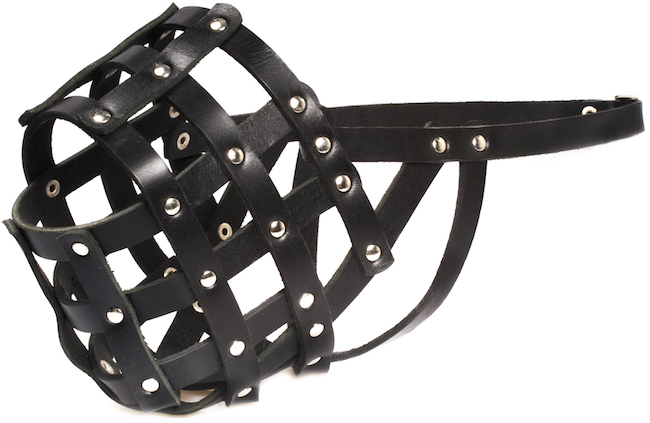Now that we have a clearer understanding of how muzzles can be used to benefit society, the dog owner, and the pup himself, let us observe what types of muzzles exist, and how they differ from each other.
Basket muzzles: The basket muzzle can be made of plastic, metal or leather. They are a stronger kind of muzzle, best suited for larger dogs. One concern about the metal basket muzzles are that in cold weather it could be very unpleasant for the pup, even causing his tongue or wet nose to stick to parts of it in extreme weather. One reason why this muzzle design is so popular is that the “basket weave” design does allow for plenty of breathing space, and good ventilation so the dog won’t overheat. Muzzles with several firm clasps are ideal, so that the dog cannot yank or pull the mask away off his face. Be careful to make sure that the muzzle fits well, and that there is no chafing on your pup’s face, head or neck.

Note: The Italian Basket muzzle is a bit more restrictive, offering less space to open the mouth. However, this protects the dog from eating small objects or licking hot spots and other sores.
Cage muzzles: Like the basket muzzle, the cage muzzle provides easy breathing, drinking, panting and barking for the dog. It is one of the least restrictive muzzle options, although it does look as if your dog is imprisoned, which is a problem for some pet owners.

Leather muzzles: These muzzles are similar to the basket muzzle style, but have a bit of increased flexibility and a quality artistic design. They tend to be more expensive, but they are biodegradable and will smell nice for the dog! Some companies even offer custom-made leather muzzles to fit the exact proportions of a dog’s head and face.

Fabric muzzle (nylon/mesh, etc). The fabric muzzles that are made out nylon are snug and meant to be worn for brief amounts of time. They are useful when visiting the vet or groomer, as they do not take much space, nor do they limit access to the rest of the pup’s head. One concern is that nylon muzzles keep the pup’s mouth tightly shut, which could prove dangerous on warm days if the dog cannot cool himself off. Another fabric option would be mesh muzzle which allows the dog to breathe and pant a little more easily than the tube-style nylon muzzles offer.
Note: Be wary of relying on Velcro-fastener muzzles, since many dogs are persistent enough to pull and pull on the muzzle until it releases.
Funny muzzles: Since many people see muzzles and assume the dog must be dangerous or threatening, the idea behind funny muzzles is to throw a humorous spin on what is seen as a punitive or protective tool. As described on our blog about the uses for muzzles, we know that people use muzzles when they go to the dog park, on walks, while traveling, when healing from injuries, when staying away from poisonous plants; not just when the dog has a biting problem. Dog training expert Cesar Millan first designed the funny muzzles to look like the dog is giving a silly smile, sticking his tongue out, or as if he has a dinosaur nose. Other designers caught on and began to follow suit. This helps kids giggle when they see a dog in a muzzle, instead of being afraid of the furry face in a cage. Because of how the funny muzzles fit, they should never be left on for long periods of time, nor should the dog go unsupervised while the muzzle is on.


